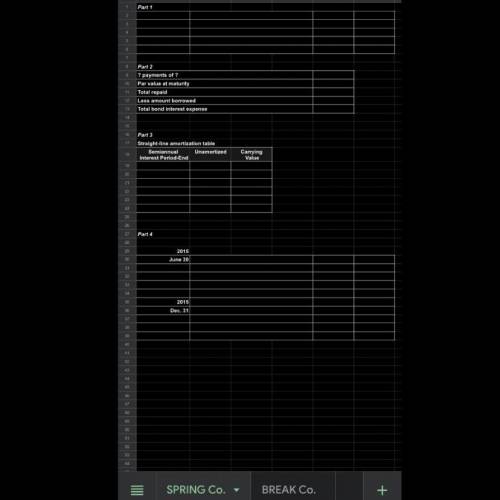
Spring Company issues $725,000 of 4%, four-year bonds dated January 1, 2015, that pay interest semiannually on June 30 and December 31. The market rate is 6% at the issue date. Bonds are sold a 94%
Break Company issues $900,000 of 10%, four-year bonds dated January 1, 2015, that pay interest semiannually on June 30 and December 31. The market rate is 6% at the issue date. Bonds are sold a 114%
Required for EACH company
Prepare the January 1, 2015, journal entry to record the bonds' issuance.
Determine the total bond interest expense to be recognized over the bonds' life.
Prepare a straight-line amortization table for the bonds' first two years.
Prepare the journal entries to record the first two interest payments.


Answers: 2


Another question on Business

Business, 21.06.2019 17:20
Luis and rosa, citizens of costa rica, moved to the united states in year 1 where they both lived and worked. in year 3, they provided the total support for their four young children (all under the age of 10). two children lived with luis and rosa in the u.s., one child lived with his aunt in mexico, and one child lived with her grandmother in costa rica. none of the children earned any income. all of the children were citizens of costa rica. the child in mexico was a resident of mexico, and the child in costa rica was a resident of costa rica. how many total exemptions (personal exemptions plus exemptions for dependents) may luis and rosa claim on their year 3 joint income tax return? a. 6 b. 5 c. 4 d. 2
Answers: 3

Business, 22.06.2019 00:30
Adds up the money earned by producers plus taxes paid to the goverment. a) income approach b) product approach c) expenditure approach
Answers: 3

Business, 22.06.2019 16:50
In terms of the "great wheel of science", statistics are central to the research process (a) only between the hypothesis phase and the observation phase (b) only between the observation phase and the empirical generalization phase (c) only between the theory phase and the hypothesis phase (d) only between the empirical generalization phase and the theory phase
Answers: 1

Business, 22.06.2019 21:10
Which of the following statements is (are) true? i. free entry to a perfectly competitive industry results in the industry's firms earning zero economic profit in the long run, except for the most efficient producers, who may earn economic rent. ii. in a perfectly competitive market, long-run equilibrium is characterized by lmc < p < latc. iii. if a competitive industry is in long-run equilibrium, a decrease in demand causes firms to earn negative profit because the market price will fall below average total cost.
Answers: 3
You know the right answer?
Spring Company issues $725,000 of 4%, four-year bonds dated January 1, 2015, that pay interest semia...
Questions


History, 22.06.2019 23:30





Mathematics, 22.06.2019 23:30



Mathematics, 22.06.2019 23:30

History, 22.06.2019 23:30



History, 22.06.2019 23:30

History, 22.06.2019 23:30

Chemistry, 22.06.2019 23:30


Biology, 22.06.2019 23:30


History, 22.06.2019 23:30



